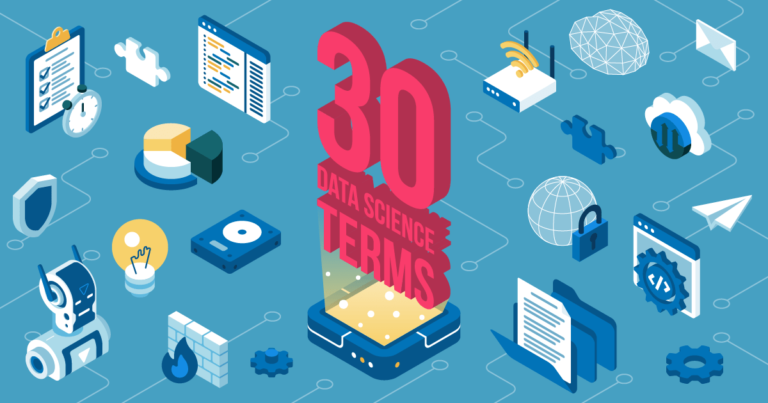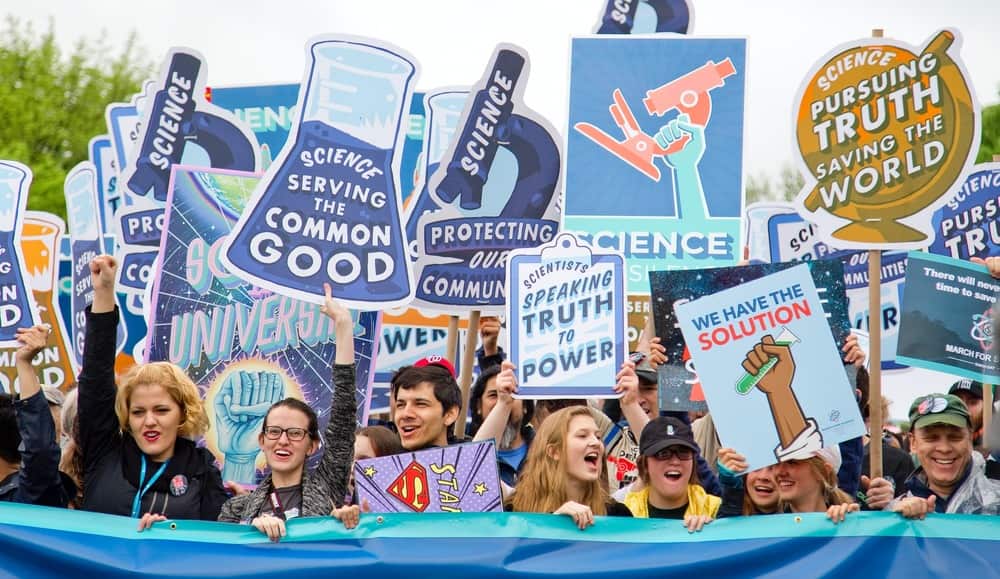30 Cool Data Science Terms You Cannot Do Without

Think of data science as a very large house with almost a countless number of rooms in it. Think of the difficulty of getting around such a house as well as the chances of getting lost at any point.
And no, this is not even an overstretch of your imagination because data science is indeed a very large field and getting around can be quite overwhelming. You notice the complexity of data science, first, when you try to define it. It is still hard to define and experts and data scientists alike are yet to agree on what exactly data science means and entails.
But there is one way to manage this situation – to not get lost in the web of what data science is. And that is to know what data science terms are. Because, like a wise man once said, “the best way to understand a subject is to first learn its words.”
And so, today we will learn some simple and common data science buzzwords, jargons, as well as terminologies which will not only help you get around but help you do it in a cool manner.
Our 30 All-Time Favorite Data Science Buzzwords
To help you understand these cool science words, we have grouped them into 3 categories (most common, common, and simple jargons). We arranged them in alphabetical order and even provided simple examples to demonstrate usage at the end of the cool science terms.
Most Common Terms
Algorithm
An algorithm is defined as a set of instructions with a known mathematical expression that can be fed collectively into a computer to solve a problem or accomplish a specific task. Linear and logistic regression are two very common algorithms.
Use Case: “The team is stuck because most of the algorithms it is using to build the project are flawed.”
Application Programming Interface (API)
This data science terminology is defined as a software intermediary that provides a medium for two separate applications to communicate with each other. It is the connectivity interface to an application through which another application can reach it.
For example, the Facebook application provides several APIs through which other smaller applications can access it and utilize Facebook services.
Use Case: “Facebook with their family of API has been crucial in helping developers serve their customers better.”
Artificial Intelligence (AI)
An AI is defined as learned intelligence or the ability of machines to think, work, and act intelligently. It can also be defined as the aspect of data science that studies, build and designs intelligent machines.
Google translator is one of the most popular demonstrations of AI.
Use Case: “Artificial Intelligence, however difficult to understand or explain, is exactly what we need in today’s world.”
Big Data
Big data is defined as any type of data that is too large to fit into a single computer. But size is not the only thing differentiating it from regular small data as big data allows for very fast processing and can exist in several variations.
Use Case: “We will have more big data as more people and device come online and become more connected.”
Business Intelligence (BI)
BI is defined as a set of strategies, applications, technologies, and even data that a company uses to generate insights and ideas that can drive growth.
Use Case: “with that much Business Intelligence, it is not surprising that Mark’s company keeps doubling their revenue every year.”
Clustering
Clustering is defined as a technique for separating or categorizing data sets into groups that are similar or closely related using methods that do not require human guidance.
Use Case: “Mark explained how they use clustering to better segment and target customers thereby improving sales and profit.”

Correlation
This is defined as a value that measures how much a set of values co-relates or depends on another set of values. We know the correlation between the sets is higher when an increase in the first set results in an increase in the second set. There is a negative or lesser correlation when an increase in the first set results in a decrease in the second set. Lastly, we record a zero correlation when a change in the first set does not affect the second set.
Use Case: “everyone knows Pearson Coefficient is the most widely used correlation coefficient in the world.”
Data Mining
This is defined as the process of using machines to analyze and examine large data sets to uncover the relationship that exists between variables. This relationship, once discovered, can then be used to create models or provide business insights.
Use Case: “to successfully execute and accomplish tasks, businesses first have to perform data mining.”
Normalization
This is a process used to rescale different datasets to allow them all exist in the same scale.
Use Case: “We need to do some normalization to our datasets, their attributes are not the same.”
Outlier
An outlier is defined as any data point that is displayed extremely far apart from the other data points. We see them displayed mostly when an exceptional error occurs in measurement.
Use Case: “Frank must have mixed up the data measurement because we keep having outliers on the graph.”

Less Common Terms
Aside from the above data science terms, many others are not commonly used. They are, of course, included in the data science glossary but are just not used as often as the above cool scientific terms.
Bootstrapping
This is any test, metric, or process that can be used to divide a large dataset into smaller subsets with likely replacement.
Use Case: “to fully appreciate the accuracy of the July sales dataset, we had to perform bootstrapping.”
Data Wrangling
To wrangle data means to format or restructure raw data until it fits some certain requirement. It also means to increase the decision-making power of raw data.
Use Case: “this new customer data may not work with our model until we do some data wrangling.”
Deep Learning
This is the process of using several neural networks or deep nets to develop models that evolve from solving simple problems to solving more complex problems.
Models that run facial recognitions are said to be deep learning models because they evolve from learning simple patterns to recognizing complex features.
Use Case: “Frank recently got awarded for building one of the best deep learning models.”
Extract, Transform, Load (ETL)
This is a 3-step process that runs behind the scenes and entails everything from when raw data is collected, translated and loaded on to the screen for analysis.
Use Case: “I think this ETL system is the best we have ever used.”
Unstructured Data
Unstructured data is usually contained within a database and means any data that does not fit into any predefined model.
Use Case: “we will not make any serious progress until we have sort out this unstructured data.”
Gradient Descent (GD)
GD is an optimization algorithm that uses iteration to minimize the cost function of a dataset. Whether it is a full batch or stochastic GD, the algorithm continues to iterate until it has determined the best parameters and reduced the error to the minimum.
Use Case: “using gradient descent to compute cost function is not a very interesting task to perform.”
Neural Network
A neural network is defined as a system with connected nodes and layers used for making accurate predictions. Data is fed into the input layer, then it moves into the hidden layers where it is analyzed before results are passed to the output layer.
Use Case: “neural network tends to imitate the way the human brain works.”
Overfitting
This is a scenario that occurs when a model takes in too much from the training data and nothing from the testing data. The resulting model performs successfully during training and fails during testing.
Use Case: “their new model failed terribly due to overfitting.”
Underfitting
This is the opposite of overfitting and occurs whenever a model or algorithm is fed too little information during training. An underfitted model is generally unsustainable as it cannot be adequately trained.
Use Case: “this graph shows only a straight line, are we having an underfitting model here?”
Web Scraping
This is the process of extracting relevant data from a target website. It entails developing scraping scripts as well as using proxies that ensure proxy management while preventing IP blocking.
Use Case: “every serious-minded and satisfaction-oriented brand must regularly perform some level of web scraping.”
Everyday Simple Jargons
Several of the terminologies used in data science are so popularly used that they can be called data science keywords.

They include:
Anonymization
This is the process of making a dataset impersonal by removing all indicators that may show who the data is referring to. These indicators such as names and addresses, once removed, makes it less restrictive and more legal to use such data.
Use Case: “we shouldn’t have any more issues with the dataset once we do the anonymization.”
Data Analysis
This is a branch of data science that uses statistical methods and accurate data to identify patterns that can be used to answer both past and present questions.
Use Case: “our company uses data analysis to try to improve customer satisfaction.”
Data Visualization
This is the process of turning data into meaningful visuals such as graphs, plots, scatter lines etc.
Use Case: “NumPy and Pandas are some of our favorite Python libraries for data visualization.”
Dataset
A dataset refers to a collection of data that has been organized into some form of structure. For instance, business data in a pool of database.
Use Case: “to make sure a model works great; we must make sure we fed in one dataset at a time.”
Database (DB)
This refers to the general pool of uncategorized and unstructured data. A database cannot be accessed without the right database programming language such as MySQL.
Use Case: “SQL is the most common language for accessing a database.”
Data Modeling
This is the process of transforming raw data into predictive, meaningful, and actionable information. To model data entails both predicting and explaining the outcomes of that data.
Use Case: “data modeling is a huge step in big data processing.”
Decision Tree
This refers to a tool popularly used by data scientists to create visuals that can promote better decision-making. The tool typically resembles a real-life tree.
Use Case: “I hate to be the one to say this, but we would have made the right call if we had used a decision tree.”
Reinforcement Learning
Reinforcement learning refers to the use of trial/error or reward/punishment methods to induce unsupervised machine learning.
Use Case: “with reinforcement learning, our new chess game model should display optimal performance in just about a week.”
Sample
This data terminology refers to a part of the larger dataset or the collection of data points we can access at a time.
Use Case: “to create a perfect model, always use the perfect sample size.”
Training & Testing
This is a vital aspect in machine learning and it involves feeding the model, first, with the training dataset. Once the results are optimal, the model is then tested to see if it can accurately predict target outcomes.
Use Case: “We are still at the training and testing phase of our new model.”
Conclusion
Everyone finds it difficult beginning with data science but we believe knowing these data science terms can help you start on the right footing.
Learn with your friends by sharing with them and subscribe to our email newsletter to make sure you never miss out on anything.




